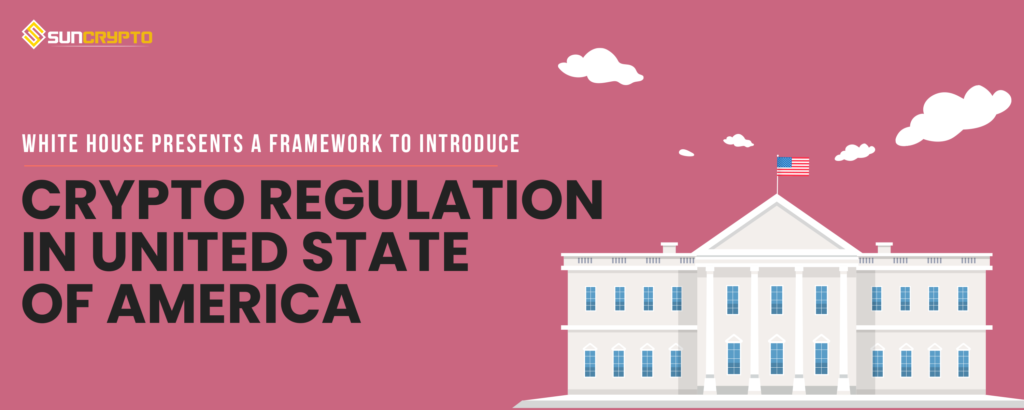The first framework of crypto regulation has been released by the US government. This covers the topics like how financial services can be developed to make borderless transactions easier than before and how the number of crypto frauds can be stopped.
Around 6 months back Joe Biden (President of the USA) asked the government agencies to look for some approaches that can be used to regulate crypto and finally some results came out of that as the US treasury presented 3 brand new reports on 16 September. The executive orders given by Joe Biden in march had very specific requirements that needed to be fulfilled in any offer or report, and these were the protection of consumers and investors; encouragement of financial stability; blocking illegitimate finance; promotion of the United States’ leadership in the world financial system and economic competitiveness; financial inclusion; and responsible innovation
Takeaways from the crypto framework
The crypto framework discusses many ways that the financial services industry should change to facilitate easier borderless transactions. The White House mostly mentioned price volatility and cryptocurrency fraud as hazards. Neither the CFTC nor the SEC currently has control over the cryptocurrency market.
Since the agency’s chairman, Gary Gensler, stated this week once more that the majority of digital assets ought to be treated as securities, the SEC in particular has been closely monitoring the cryptocurrency market. Additionally, this research has urged the Federal Trade Commission and the Consumer Financial Protection Bureau to oppose unethical business practices.
-
-
Fighting illicit finance
This was one of the measures that were proposed in the framework where it was mentioned that the regulations will focus on reducing illegal activity in this field. A White House fact sheet states that the president will consider whether to ask Congress to amend the Bank Secrecy Act, anti-tip-off laws, and laws against unlicensed money transmitting to explicitly apply to providers of digital asset services, such as digital asset exchanges and nonfungible token (NFT) platforms.
-
Safeguarding the financial stability
According to a fact sheet from the White House, “digital assets and the traditional financial system are increasingly interconnected, offering pathways for volatility to have ripple effects.” A major U.S. dollar-pegged stablecoin project called TerraUSD collapsed in May, costing investors tens of billions of dollars as they withdrew in a panic that some have likened to a bank run.
The project gained legitimacy thanks to widespread support and public PSAs from reputable financial organizations, supporting the idea that everything was real.The administration claims that in order to make stablecoins “safer,” the Treasury will collaborate with other agencies. To “identify, track, and analyze emerging strategic risks that relate to digital asset markets”. Also “work with financial institutions to bolster their capacity to identify and minimize security flaws by sharing information and promoting a wide range of data sets and analytical tools.” -
Introduction of Central Bank Digital Currency
The USA already has a different form of digital US dollar. There is an electronic US dollar that comes under the system of fractional reserve banking and these are partially backed by reserves. And there are stablecoins like Tether which are pegged to the US dollar. Now soon there might be a CBDC coin which will be like a digital twin of the US dollar and will be under the control of the central authority. The elimination of the use case for cryptocurrency in the United States accordingly. Federal Reserve Chair Jerome Powell says that the introduction of CBDC will be the key to the elimination of the use case of cryptocurrency in the United States. If there was a digital US currency, “you wouldn’t need stablecoins; you wouldn’t need cryptocurrencies,” Powell added.
-
Where it’s lacking?
The issue is that no laws have yet been mandated. Hence the new instructions use the power of already-existing regulators. Like the Securities and Exchange Commission and the Commodity Futures Trading Commission.
The report offers general recommendations for an increase in risks. But it does not offer ideas for specific crypto regulations or legislation. The report just included the introduction of CBDC but no single decision have made for the issues. This was just a technical report to help people understand the concept of CBDC.
For more cryptocurrency-related content check out Suncrypto Academy.
Disclaimer: Crypto products and NFTs are unregulated and can be highly risky. There may be no regulatory recourse for any loss from such transactions. All content provided is for informational purposes only, and shall not be relied upon as financial/investment advice. Opinions shared, if any, are only shared for information and education purposes. Although the best efforts have been made to ensure all information is accurate and up to date, occasionally unintended errors or misprints may occur. We recommend you to please do your own research or consult an expert before making any investment decision. You may write to us at [email protected].





